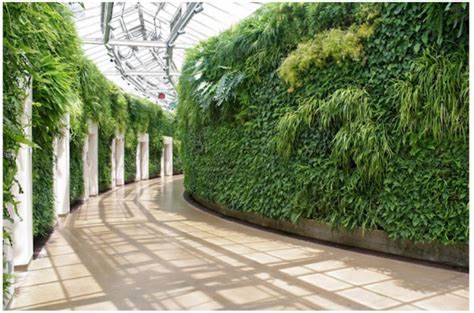
The Allure and Significance of Vertical Gardens
Introduction
Vertical gardens have gained popularity in recent years due to their captivating nature. This article provides an overview of the allure of vertical gardens and explores their relevance and importance in today’s world.
Historical Background
Vertical gardening has its roots in ancient civilizations, such as the Hanging Gardens of Babylon, where innovative use of vertical space for cultivating plants was showcased. Over time, vertical gardens have evolved and gained historical significance by being integrated into architectural designs and symbolizing wealth and power.
Key Concepts and Definitions
Vertical gardens refer to the practice of growing plants vertically, using structures like walls, facades, or hanging systems. These gardens maximize limited space and create a harmonious blend of nature and architecture. Green enthusiasts play a crucial role in vertical gardening, actively participating in the creation and maintenance of these gardens.
Benefits of Vertical Gardens for Green Enthusiasts
Vertical gardens offer numerous benefits for green enthusiasts, including:
Increased green space in urban areas: Vertical gardens provide a solution to the scarcity of green areas in cities, promoting biodiversity and improving the urban environment.
Improved air quality and biodiversity: Vertical gardens help reduce air pollution by absorbing carbon dioxide and releasing oxygen. They also attract various bird species and insects, contributing to a healthier ecosystem.
Aesthetic appeal and psychological benefits: Vertical gardens add beauty and visual interest to buildings and public spaces, enhancing the overall ambiance. Exposure to greenery has been shown to have a positive impact on mental health, reducing stress and enhancing well-being.
Techniques and Methods for Creating Vertical Gardens
There are several techniques and methods for creating vertical gardens, including:
Living walls: Plants grow vertically on a structure, either indoors or outdoors. Various systems, such as modular panels or hydroponics, can be used to create living walls.
Green facades: Climbing plants cover the exterior walls of buildings, creating a natural and visually appealing green layer.
Hanging gardens: Suspended pots or containers are used to grow plants vertically. This technique is suitable for small spaces and can be easily implemented indoors and outdoors.
Sustainability and Environmental Impact of Vertical Gardens
Vertical gardens contribute to sustainability and have a positive environmental impact through:
Water conservation and irrigation systems: Vertical gardens can be designed to incorporate efficient irrigation systems, reducing water usage compared to traditional gardens. Techniques like drip irrigation and graywater recycling can be employed.
Use of recycled materials: Vertical gardens often utilize recycled materials for their structures, reducing the environmental footprint. For example, repurposed pallets or recycled plastic panels can be used as planters.
Impact on the urban heat island effect: Vertical gardens help mitigate the urban heat island effect by reducing surface temperatures and providing shade. This can lower energy consumption for cooling buildings and improve overall city comfort.
Case Studies or Examples
Successful vertical garden projects around the world serve as inspirational examples. For instance, the Bosco Verticale in Milan, Italy, is a remarkable residential building with vertically integrated gardens that enhance the quality of life for its residents. Profiles of green enthusiasts and their experiences with vertical gardening showcase the transformative power of these gardens, inspiring others to embrace vertical gardening.
Current Trends or Developments
Vertical gardens are experiencing growing popularity in urban areas as more people recognize their benefits. Cities worldwide are incorporating vertical gardens into their urban planning to create healthier and more sustainable environments. Commercial and residential buildings are integrating vertical gardens as a unique and eco-friendly feature, enhancing aesthetics and promoting well-being. Innovations in vertical gardening techniques and technology continue to emerge, making vertical gardening more accessible and efficient.
Challenges or Controversies
Maintenance and upkeep of vertical gardens can be challenging, requiring regular care and attention. Proper irrigation, pruning, and pest control are essential to ensure the health and longevity of the plants. There are concerns regarding the potential impact of vertical gardens on the structural integrity of buildings. Proper engineering and design considerations are crucial to ensure the safety and stability of the structures. Differing opinions exist regarding the aesthetic appeal of vertical gardens, with some finding them visually overwhelming or unsightly.
Future Outlook
Vertical gardens have the potential to become more mainstream as awareness grows and technology advances. They offer a sustainable solution to urban green spaces, benefiting both the environment and the well-being of individuals. The integration of vertical gardens in sustainable urban planning is expected to increase, creating resilient cities that prioritize green infrastructure and promote a healthy lifestyle. Advancements in vertical gardening technology and techniques will continue to emerge, making it easier and more efficient for individuals to implement and maintain their own vertical gardens.
Conclusion
In conclusion, vertical gardens hold immense allure and significance in today’s world. They provide a solution to the lack of green spaces in urban areas, offer numerous benefits for green enthusiasts, and contribute to sustainability and environmental well-being. With growing popularity and ongoing innovations, vertical gardens have the potential to shape the future of urban landscapes.